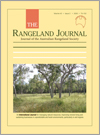RJ19092Vegetation change 10 years after cattle removal in a savanna landscape
Ten years of vegetation change after cattle removal in a savanna landscape in northern Australia are documented in detail. Predicted improvements in landscape health were evident, as measured by proportional increases in key native perennial palatable species, but there were also some unexpected and perverse results. This study builds on knowledge of how disturbed landscapes respond to cattle removal, demonstrates that recovery in conservation reserves may be complex, and suggests possible indicator plant species which can be used to monitor the effects of grazing removal in the local area.




